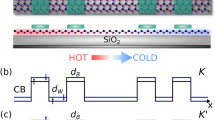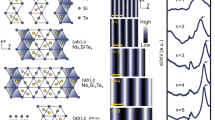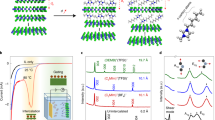Abstract
Silicene, germanene and stanene are part of a monoelemental class of two-dimensional (2D) crystals termed 2D-Xenes (X = Si, Ge, Sn and so on) which, together with their ligand-functionalized derivatives referred to as Xanes, are comprised of group IVA atoms arranged in a honeycomb lattice — similar to graphene but with varying degrees of buckling. Their electronic structure ranges from trivial insulators, to semiconductors with tunable gaps, to semi-metallic, depending on the substrate, chemical functionalization and strain. More than a dozen different topological insulator states are predicted to emerge, including the quantum spin Hall state at room temperature, which, if realized, would enable new classes of nanoelectronic and spintronic devices, such as the topological field-effect transistor. The electronic structure can be tuned, for example, by changing the group IVA element, the degree of spin–orbit coupling, the functionalization chemistry or the substrate, making the 2D-Xene systems promising multifunctional 2D materials for nanotechnology. This Perspective highlights the current state of the art and future opportunities in the manipulation and stability of these materials, their functions and applications, and novel device concepts.
This is a preview of subscription content, access via your institution
Access options
Access Nature and 54 other Nature Portfolio journals
Get Nature+, our best-value online-access subscription
$29.99 / 30 days
cancel any time
Subscribe to this journal
Receive 12 print issues and online access
$259.00 per year
only $21.58 per issue
Buy this article
- Purchase on Springer Link
- Instant access to full article PDF
Prices may be subject to local taxes which are calculated during checkout



Similar content being viewed by others
References
Fiori, G. et al. Electronics based on two-dimensional materials. Nat. Nanotech. 9, 768 (2014).
Ferrari, A. C. et al. Science and technology roadmap for graphene, related two-dimensional crystals, and hybrid systems. Nanoscale 7, 4598 (2015).
Akinwande, D. et al. Large-area graphene electrodes: using CVD to facilitate applications in commercial touchscreens, flexible nanoelectronics, and neural interfaces. IEEE Nanotechnol. Magazine 9, 6 (2015).
Balendhran, S., Walia, S., Nili, H., Sriram, S. & Bhaskaran, M. Elemental analogues of graphene: silicene, germanene, stanene, and phosphorene. Small 11, 640 (2015).
Takaeda, K. & Shiraishi, K. Theoretical possibility of stage corrugation in Si and Ge analogs of graphite. Phys. Rev. B 50, 14916 (1994).
Cahangirov, S., Topsakal, M., Akturk, E., Sahin, H. & Ciraci, S. Two- and one-dimensional honeycomb structures of silicon and germanium. Phys. Rev. Lett. 102, 236804 (2009).
Guzman-Verri, G. G. & Voon, L. C. L. Y. Electronic structure of silicon-based nanostructures. Phys. Rev. B 76, 075131 (2007).
Grazianetti, C., Cinquanta, E. & Molle, A. Two-dimensional silicon: the advent of silicene. 2D Mater. 3, 012001 (2016).
Liu, C. C., Feng, W. X. & Yao, Y. G. Quantum spin Hall effect in silicene and two-dimensional germanium. Phys. Rev. Lett. 107, 076802 (2011).
Kane, C. L. & Mele, E. J. Quantum spin Hall effect in graphene. Phys. Rev. Lett. 95, 226801 (2015).
Houssa, M., Dimoulas, A. & Molle, A. Silicene: a review of recent experimental and theoretical investigations. J. Phys. Cond. Matt. 27, 253002 (2015).
Xu, Y. et al. Large-gap quantum spin Hall insulators in tin films. Phys. Rev. Lett. 111, 136804 (2013).
van den Broek, B. et al. Two-dimensional hexagonal tin: ab initio geometry, stability, electronic structure and functionalization. 2D Mater. 1, 021004 (2014).
Vogt, P. et al. Silicene: compelling experimental evidence for graphenelike two-dimensional silicon. Phys. Rev. Lett. 108, 155501 (2012).
Lin, C. L. et al. Structure of silicene grown on Ag(111). Appl. Phys. Express 5, 045802 (2012).
Feng, B. J. et al. Evidence of silicene in honeycomb structures of silicon on Ag(111). Nano Lett. 12, 3507 (2012).
Chiappe, D., Grazianetti, C., Tallarida, G., Fanciulli, M. & Molle, A. Local electronic properties of corrugated silicene phases. Adv. Mater. 24, 5088 (2012).
Meng, L. et al. Buckled silicene formation on Ir(111). Nano Lett. 13, 685 (2013).
Fleurence, A. et al. Experimental evidence for epitaxial silicene on diboride thin films. Phys. Rev. Lett. 108, 245501 (2012).
Scalise, E. et al. Vibrational properties of epitaxial silicene layers on (111)Ag. Appl. Surf. Sci. 291, 113 (2014).
Tsoutsou, D., Xenogiannopoulou, E., Golias, E., Tsipas, P. & Dimoulas, A. Evidence for hybrid surface metallic band in (4 × 4) silicene on Ag(111). Appl. Phys. Lett. 103, 231604 (2013).
Davila, M. E., Xian, L., Cahangirov, S., Rubio, A. & Le Lay, G. Germanene: a novel two-dimensional germanium allotrope akin to graphene and silicene. New J. Phys. 16, 095002 (2014).
Li, L. F. et al. Buckled germanene formation on Pt(111). Adv. Mater. 26, 4820 (2014).
Derivaz, M. et al. Continuous germanene layer on Al(111). Nano Lett. 15, 2510 (2015).
Bampoulis, P. et al. Germanene termination of Ge2Pt crystals on Ge(110). J. Phys. Cond. Matt. 26, 442001 (2014).
D'Acapito, F. et al. Evidence for germanene growth on epitaxial hexagonal (h)-AlN on Ag(111). J. Phys. Cond. Matt. 28, 045002 (2016).
Zhu, F. F. et al. Epitaxial growth of two-dimensional stanene. Nat. Mater. 14, 1020 (2015).
Mannix, A. J. et al. Synthesis of borophenes: anisotropic, two-dimensional boron polymorphs. Science 350, 1513 (2015).
Feng, B. et al. Experimental realization of two-dimensional boron sheets. Nat. Chem. 8, 563–568 (2016).
Zhang, J. L. et al. Epitaxial growth of single layer blue phosphorus: a new phase of two-dimensional phosphorus. Nano Lett. 16, 4903–4908 (2016).
Bianco, E. et al. Stability and exfoliation of germanane: a germanium graphane analogue. ACS Nano 7, 4414 (2013).
Jiang, S., Arguilla, M. Q., Cultrara, N. D. & Goldberger, J. E. Covalently-controlled properties by design in group IV graphane analogues. Acc. Chem. Res. 48, 144 (2015).
Wohler, F. Ueber verbindungen des siliciums mit sauerstoff und wasserstoff. Liebigs Ann. Chem. 127, 257 (1863).
Jiang, S. et al. Improving the stability and optical properties of germanane via one-step covalent methyl-termination. Nat. Commun. 5, 3389 (2014).
Nakano, H. et al. Preparation of alkyl-modified silicon nanosheets by hydrosilylation of layered polysilane (Si6H6). J. Am. Chem. Soc. 134, 5452 (2012).
Liang, X. H., Zhang, Q. H., Lay, M. D. & Stickney, J. L. Growth of Ge nanofilms using electrochemical atomic layer deposition, with a “bait and switch” surface-limited reaction. J. Am. Chem. Soc. 133, 8199 (2011).
Qiu, J. et al. From silicene to half-silicane by hydrogenation. ACS Nano 9, 11192 (2015).
Yu, H. et al. Scanning tunneling microscopy of ethylated Si(111) surfaces prepared by a chlorination/alkylation process. J. Phys. Chem. B 110, 23898 (2006).
van de Walle, C. G. & Northrup, J. E. First-principles investigation of visible light emission from silicon-based materials. Phys. Rev. Lett. 70, 1116 (1993).
Xu, Y., Tang, P. Z. & Zhang, S. C. Large-gap quantum spin Hall states in decorated stanene grown on a substrate. Phys. Rev. B 92, 081112 (2015).
Chiappe, D. et al. Two-dimensional Si nanosheets with local hexagonal structure on a MoS2 surface. Adv. Mater. 26, 2096 (2014).
Zhang, L. et al. Structural and electronic properties of germanene on MoS2 . Phys. Rev. Lett. 116, 256804 (2016).
Molle, A. et al. Hindering the oxidation of silicene with non-reactive encapsulation. Adv. Funct. Mater. 23, 4340 (2013).
Tao, L. et al. Silicene field-effect transistors operating at room temperature. Nat. Nanotech. 10, 227 (2015).
Ezawa, M. Valley-polarized metals and quantum anomalous Hall effect in silicene. Phys. Rev. Lett. 109, 055502 (2012).
Bernevig, B. A., Hughes, T. L. & Zhang, S. C. Quantum spin Hall effect and topological phase transition in HgTe quantum wells. Science 314, 1757 (2006).
Konig, M. et al. Quantum spin hall insulator state in HgTe quantum wells. Science 318, 766 (2007).
Si, C. et al. Functionalized germanene as a prototype of large-gap two-dimensional topological insulators. Phys. Rev. B 89, 115429 (2014).
Tang, P. Z. et al. Stable two-dimensional dumbbell stanene: a quantum spin Hall insulator. Phys. Rev. B 90, 121408(R) (2014).
Ezawa, M. J. Monolayer topological insulators: silicene, germanene, and stanene. Phys. Soc. Jpn 84, 121003 (2015).
Ezawa, M. Spin valleytronics in silicene: quantum spin Hall-quantum anomalous Hall insulators and single-valley semimetals. Phys. Rev. B 87, 155415 (2013).
Wang, J., Xu, Y. & Zhang, S. C. Two-dimensional time-reversal-invariant topological superconductivity in a doped quantum spin-Hall insulator. Phys. Rev. B 90, 054503 (2014).
Ezawa, M. Quantized conductance and field-effect topological quantum transistor in silicene nanoribbons. Appl. Phys. Lett. 102, 172103 (2013).
Vandenberghe, W. G. & Fischetti, M. V. Calculation of room temperature conductivity and mobility in tin-based topological insulator nanoribbons. J. Appl. Phys. 116, 173707 (2014).
Xu, Y., Gan, Z. X. & Zhang, S. C. Enhanced thermoelectric performance and anomalous Seebeck effects in topological insulators. Phys. Rev. Lett. 112, 226801 (2014).
Rachel, S. & Ezawa, M. Giant magnetoresistance and perfect spin filter in silicene, germanene, and stanene. Phys. Rev. B 89, 195303 (2014).
Wu, S. C., Shan, G. C. & Yan, B. H. Prediction of near-room-temperature quantum anomalous Hall effect on honeycomb materials. Phys. Rev. Lett. 113, 256401 (2014).
Wintterlin, J. & Bocquet, M. L. Graphene on metal surfaces. Surf. Sci. 603, 1841 (2009).
Scalise, E. et al. Vibrational properties of silicene and germanene. Nano Res. 6, 19 (2013).
Acknowledgements
We thank C. Grazianetti, E. Cinquanta, L. Tao, M. Fanciulli, V.V. Afanas'ev, A. Stesmans, W. Vandenberghe, M. Fischetti, A. Dimoulas, D. Tsoutsou, C. Pirri and M. Ezawa for fruitful discussions. We also thank J. Wozniak of UT-Austin TACC Center for the renderings of Fig. 3. A.M. is partially supported by the National Research Council of Italy (CNR) under the joint lab project 'SFET' (2014 call). J.G. acknowledges partial support from the Center for Emergent Materials: an NSF MRSEC under award number DMR-1420451, partial support from NSF EFRI-1433467, and the Camille and Henry Dreyfus Foundation. M.H acknowledges financial support from the KU Leuven Research Funds, project GOA/13/011. A.M. and M.H. also acknowledge partial financial support from the EU-FP7 FET-Open grant no. 270749 ('2D-Nanolattices' project). Y.X. acknowledges support from Tsinghua University Initiative Scientific Research Program and the National Thousand-Young-Talents Program. S.C.Z. is supported by the Department of Energy, Office of Basic Energy Sciences, Division of Materials Sciences and Engineering, under contract DE-AC02-76SF00515 and by FAME, one of six centres of STARnet, a Semiconductor Research Corporation programme sponsored by MARCO and DARPA. D.A acknowledges support from the Army Research Office (ARO), the Presidential Early Career Award for Engineers and Scientists (PECASE), and the Gordon and Betty Moore Foundation.
Author information
Authors and Affiliations
Corresponding authors
Ethics declarations
Competing interests
The authors declare no competing financial interests.
Rights and permissions
About this article
Cite this article
Molle, A., Goldberger, J., Houssa, M. et al. Buckled two-dimensional Xene sheets. Nature Mater 16, 163–169 (2017). https://doi.org/10.1038/nmat4802
Received:
Accepted:
Published:
Issue Date:
DOI: https://doi.org/10.1038/nmat4802
This article is cited by
-
Microwave graphitic nitrogen/boron ultradoping of graphene
npj 2D Materials and Applications (2024)
-
Room-temperature ferromagnetism and piezoelectricity in metal-free 2D semiconductor crystalline carbon nitride
Nano Research (2024)
-
High optical spin-filtering in antiferromagnetic stanene nanoribbons induced by band bending and uniaxial strain
Scientific Reports (2023)
-
Ferromagnetism in two-dimensional metal dibromides induced by hole-doping
Scientific Reports (2023)
-
Free-standing 2D gallium nitride for electronic, excitonic, spintronic, piezoelectric, thermoplastic, and 6G wireless communication applications
NPG Asia Materials (2023)



